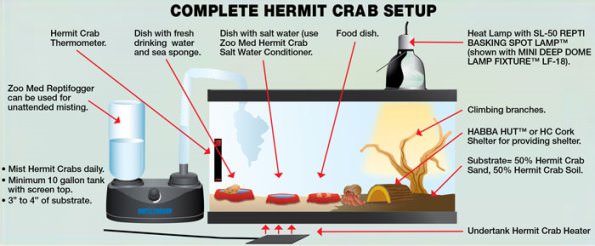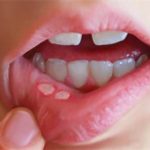How to care for hermit crabs? Hermit crabs (lovingly called hermies) are great pets to keep. It is also a chance that they are not as cute or cuddly as a puppy, yet they are enjoyable to play with and will show kids the significance of caring for an alternate living creature. Follow these steps to set up a crab’s natural surroundings (a crabitat) and care for your hermie.

(A) Setting Up Your “Crabitat” to Care for Hermit Crabs
1.) Tank Size to Care for Hermit Crabs
Make sure you get the right size of tank. A gallon tank of ten or twenty is good for two to four small hermits. If the capacity of the tank is increased to twenty to forty then it is good for twelve small or three to four large hermits. Hermit crabs are known for being their social identity and ought to have no less than one other crab with them. The proper home for your crabs ought to be one that holds in humidity, yet lets in fresh air. A fish tank or reptile aquarium typically does pleasantly. You can even flush out that old releasing tank from the storage room and utilization it! Acrylic terrariums have a tendency to work better, as they hold the humidity and heat all the more productively.
2.) Humidity to Care for Hermit Crabs
Make sure your hermie’s house is the right humidity. You ought to purchase a hygrometer (humidity gage) and a thermometer. These will help you to screen and keep up an ideal temperature and relative humidity of around 75-85 degrees F, and 75-85% relative humidity. Hermit crabs breathe through (solidified) gills, and can’t breathe properly unless the air is damp enough. The perfect reach is no less than 75% relative humidity. Humidity lower than 70% will lead to choking, which kills gradually over a few weeks or months and is to a great degree excruciating.
A great way to expand your tank’s humidity naturally is to add natural moss to your tank. It builds the humidity, and hermit crabs eat it. Search for moss like Fluker’s Reptile Moss at your local pet store. Wipes likewise work well, and can likewise be found at a pet store. Yet wipes get grimy effectively and need to be changed out every two to three weeks.
3.) Temperature to Care for Hermit Crabs
Make sure your tank is the right temperature. Hermit crabs are the animals that live in tropical regions and do best in warm temperatures. 75-85°f is the proper temperature range. Heat harm is irreversible, and temperatures that are excessively low, slow down a crab’s digestion system. An under-tank heater intended for hermit crabs, straddling on the back of the tank is a good way to keep your tank muggy. An improper environment can cause your crab to wind up lethargic and latent, lose appendages and could conceivably cause death.
4.) Get Substrate to Care for Hermit Crabs
Substrate is the layer of material you place on the floor of the tank. Dechlorinated salt water should be used to wet the sand to a “sand-mansion” consistency. You additionally can utilize compacted coconut fiber (Sold as Eco-Earth or Jungle Bedding). Stretch the coco-fiber in the same salt water you would give your crabs to counteract mold/buildup. Substrates that crabs can not dig in, for example, aquarium rock (can not hold hollows) or calcium sand (clusters and can have a foul smell) are not acceptable as a substrate. Your substrate ought to be no less than 3-5 times the stature of your largest crab, and ought to be a material the crabs can undoubtedly dig and assemble surrenders to calm stress, hide, and molt.
Numerous crabs likewise like to bury and even molt in sodden moss, for example, Fluker’s Reptile Moss (not brightening or Spanish moss!)
5.) Keep the Substrate Clean to Care for Hermit Crabs
Messy substrate can prompt mold which can be harmful to your hermies. Change it at regular intervals. In any case, consistently you ought to do a concise verify whether there is any mold growing, or a ground dwelling insect or bug infestation. In the event that you see both of these things, change the substrate instantly. It’s a good thought to “spot clean” any waste and food the crabs have dragged from the food bowl or covered. You ought to just clean the substrate when your hermit crab is not molting (a crab who has tunneled underground and is experiencing a methodology to shed and regrow its exoskeleton). A molting crab is not to be moved.
On the off chance that you want to go the extra mile, you can sanitize sand substrate. Sand can be cleaned in the broiler. Put the sand in a large broiling container (one utilized just for this reason!) and place it in the broiler. Set the temperature from 250 degrees (F), (120 degrees Celsius) and then leave it for the coming two hours.
Once every two to three weeks, heat up all the shells and dishes in your tank in a skillet of dechlorinated salt water. Get play-toys. Hermit crabs love to climb! Actually, in the wild, they will climb large rocks uncovered by the low tide to scan for food. They are sometimes called “tree crabs” because they will climb trees to eat creepy crawlies and vegetation. Don’t, nonetheless, purchase painted toys, as paint could be harmful to crabs in the event that it is ingested. Some toy thoughts are:
Climbing toys to care for hermit crabs. Providing for them things to climb on is an unquestionable requirement; choya logs or stumps are great for this. Choya is not toxic, and has openings in it for them to take hold of. You can incline it in a corner of your tank, just don’t place it excessively high or your crabs will climb out. Lego’s and hemp nets work well as well.
Natural toys to care for hermit crabs: Natural rocks and seashells that you pick up at the shoreline are great things to dissipate around the “crabitat.” Clam shells even make great food dishes. Just make a point to bubble them in bubbling water with the goal that they get to be sanitized before you place them in the tank.
Plastic toys to care for hermit crabs: Plastic plants made for reptiles are great for crabs to climb and hide in, just remember to utilize the lid of your tank so the crabs can’t climb out. Verify they aren’t eating the plastic, and evacuate it right away in the event that they are!
Never utilize reptile “half pine logs”, as pine is an aggravation to the crabs and can be toxic.
6.) Concealing Place to Care for Hermit Crabs
Provide your hermies with a concealing place. Hermit crabs, in the same way as most animals, desire to have a place to feel secure and hide when they feel threatened. You can use broken pots, large shells, and so on. Just verify that the crab won’t get stuck and, ideally, has the capacity dig out on the off chance that it does.
7.) Live Plants to Care for Hermit Crabs
Add some live plants to your tank. Live plants can be a great expansion to any tank. In particular, plants like bamboo (verify its genuine bamboo and not Dracaena Sanderiana, which is sold as “lucky bamboo”), Venus fly traps bromeliads (air plants) and arachnid plants are among the safe plants. Be admonished -your hermit crabs may nibble on them, so there’s no ensure the plants will have sufficient energy to grow.
8.) Water to Care for Hermit Crabs
Provide your hermies with water. All types of hermit crab need to have admittance to both freshwater and saltwater. Here you will be required to have two water dishes for the crabs. Hermit crabs need to adjust the saltiness of the water in their shells; the dishes ought to be at any rate deep enough that your crab can get water in its shell (C. Perlatus, A.k.a. Strawberry hermit crabs, need to have the capacity to submerge themselves), yet verify they find themselves able to get out. The most effective method to do it is to provide them with an inclining water zone, where one part is shallow and simple to climb out of, on the other hand the second one is deep and they can submerge themselves in the water. Line the zone with rocks or something they can hold on. Plastic is excessively tricky and they will experience difficulty climbing the slant.
On the off chance that you have large and small crabs together, a small natural wipes in the water dishes so it is deep enough so large crabs can give water access its shell, yet small crabs won’t get to be caught in the water dish and suffocate.
You can purchase an aquarium salt for marine fish (not freshwater fish) from most pet stores and a little goes a long way. Never utilize salt expected for human utilization because the opposition to hardening specialists can be harmful. Most hermit crab brand salts are likewise table salts. Premixed” “hermit crab water” does not have the right saltiness. Utilize a brand like Instant Ocean, Oceanic, and so forth.
9.) De-Chlorination to Care for Hermit Crabs
Make sure the water is dechlorinated. The chlorine, chloramines and substantial metals in most tap water can slaughter hermit crabs by bringing about the gills to rankle (creating consequent suffocation). Maturing the water will uproot the chlorine, yet not the chloramines, so dechlorinator is an unquestionable requirement in the event that you utilize tap water. Zoomed water conditioner is a good brand to utilize.
On the off chance that you would prefer not to dechlorinate tap water, you can utilize spring water. Notwithstanding, verify nothing has been added to the water. For instance, Dasani water contains magnesium sulfate “for taste”, and that is terrible for the crabs.
(B) Other Ways to Care for Hermit Crabs
10.) Different Hermits to Care for Hermit Crabs
Know that there are different sorts of hermit crabs you can purchase. There are six sorts of hermit crabs available to be purchased in the United States. Every one of them are in the variety Coenobita. The Purple Pincher is the best one to begin with because the others are more fragile and oblige a great deal more nitty gritty and extreme care.
The most well-known sort out there is the Caribbean (Coenobita clypeatus,) which is additionally called “PP” for purple pincher because of, you got it, its large purple pincher. Wild Purple Pinchers are available in the Caribbean Islands. Doubtlessly, when you see a hermit crab in a store, you will be seeing one of these fellows. Alternate sorts are Rugosus “Mat” or “Ruggy” (rugosus), Strawberry (perlatus), Ecuadorian or “E” (compressus), Cavipe or “Cav” (cavipes), Komurasaki “Viola” (violascens), Indonesian or “Indo” (brevimanus).
11.) Handle With Care to Care for Hermit Crabs
Handle your hermies with care. You are required to have patience with them when you first get your hermies- -they will take a little time to adjust to their new home. When you get your hermit crabs, abandon them in the enclosure for a couple of days. When you see that they don’t hunch into their shell when you pass by then hold up an alternate day and try to hold your hermit crab. Let your hermit crab investigate your hand and get used to you.
When you get them home, they experience a “De-stressing” period that can take as meager as a couple of days and as long as two months. Amid this time, change out their food and water routinely and don’t exasperate them. Sometimes, even with the best endeavors of even the most experienced crabber, and kick the bucket.
12.) Check Needs to Care for Hermit Crabs
Know that crabs experience molting and need extra shells. In the event that your crab digs under the substrate for a few weeks, don’t stress. As long as it doesn’t stink like dead fish, he’s OK. Kindly don’t exasperate your crab amid this time. He will need to be separated from everyone else and on the off chance that he is disturbed, the stress could slaughter him. Occasionally, a crab’s exoskeleton gets a little tight, and just as a snake sheds its skin, or in the case of a crab that is known to shed its exoskeleton and grow a little bit.
On the off chance that you have a sick crab, don’t freeze. Keep a separation tank in a closet with enough substrate to dig under totally and adequate food and water. In the event that a crab is acting sick. This tank ought to likewise be kept with proper humidity and temperature as was specified beforehand.
13.) Greater Shells to Care for Hermit Crabs
Provide shells for your hermie to care for hermit crabs. At the point when hermit crabs grow, they need greater shells. It is paramount to keep a lot of extra hermit crab shells like your crabs’ sizes in the tank at all times. When a month or thereabouts, pivot a couple of undisturbed shells out with different styles of shells.
Purple Pincher Hermit Crabs incline toward the shells with round, roundabout openings. They will pick round openings over the oval openings. Ecuadorian Hermit Crabs will lean toward an oval opening, because they have complimented mid-regions.
Never purchase painted shells! In spite of the fact that organizations may guarantee the paint is sheltered, the paint can chip off, and if the crabs consume it, it can be poisonous. Most hermit crabs, when displayed with a decision, will pick a “natural” shell over a painted one, regardless of the fact that its not the right size. See the Warnings for data on what sorts of shells to avoid.
14.) Eating Methodology to Care for Hermit Crabs
Provide an enduring and differed eating methodology. Hermit crabs are scroungers by nature and will eat practically anything. Be careful with business food, as it has numerous preservatives, for example, copper sulfate, that may harm your little hermit. Don’t bolster them anything hot, hot, or with preservatives in it.
Hermit crabs love silver sides and shrimp that are fresh, stop dried krill, blood worms, and so on., and other seafood. You can typically purchase these fishy foods at your local supermarket.
In the event that you cook, set aside a bit of steak or chicken, non-marinated to flame broil daintily for the crabs. They likewise eat crude meat.
In the event that you have more than twenty crabs or somewhere in the vicinity, try getting a fish head from a local fish market. They are normally upbeat to dole them out. You can put the majority of your crabs in a large tank or a large clean Rubbermaid stockpiling holder, (clear, no lid, or lid with VERY large gaps cut in it) drop in the fish head, and a water-bowl, and abandon them in there to eat for a couple of hours. You will for the most part likely not want to do this frequently, since the stench is really terrible, yet your crabs will love you for it!
15.) Leafy Foods to Care for Hermit Crabs
know what leafy foods hermies like to care for hermit crabs. Beside eating meat, hermit crabs additionally love different products of the soil, in addition to different scraps (they are foragers when its all said and done.) Remember to change their food very nearly consistently or night. Hermit crabs love to bury their uneaten food, and this can cause molding and is untidy.
Hermit crabs love fresh apples and oranges like pineapple, apple, pears, grapes, melon, watermelon, mango, papaya, strawberries, bananas, and so forth. Wash your tree grown foods altogether before you cut it, in order to get rid of pesticides.
Crabs will go insane for coconut shavings.
Hermit crabs will likewise eat natural peanut spread on entire wheat toast, hard boiled eggs, egg shells (boiled), popcorn (plain, unsalted and unbuttered).
Avoid anything from the Allium types of plants (onion, garlic, and so forth).
16.) Play With Them to Care for Hermit Crabs
Some Hermit crabs love consideration. When they are astir, carefully take them out of their crabitat. What do they like to do? Climb! Given them a chance to climb everywhere on your shirt while you are staring at the TV or activity them as they stroll crosswise over both your hands (like a crab treadmill). It is critical that they never fall, and are not out excessively long because they need humidity. Falling from a stature of 3 feet (0.9 m). Can be lethal for them, and apprehension of falling is the most obvious reason crabs pinch. Maintain them in a situation where they aren’t going to fall and they likely won’t pinch.
Remember that they need humidity. Normal house humidity is just 40% and even less with AC and heat. At the point when a crab’s gills are presented to low humidity, it feels like how we feel when we hold our breath for a really long time.
17.) Be Mindful to Care for Hermit Crabs
Be mindful that hermit crabs may pinch. While they for the most part pinch just when they are apprehensive or feel cornered, they may pinch for no reason, so be arranged. Fogging or running tap water on crabs to get them to discharge their grip can harm them and will probably bring them about holding on longer and tighter. Kindly try to remain extremely careful when handling them. You can also stay away from being pinched by holding your hand level and tight so that the hermit crab won’t have (as much) skin to pinch.
Other Useful Tips to Care for Hermit Crabs:
At the point when your crab pinches you, it is not because he’s mean, but since he’s either scared of falling from your hand or hungry. Put him back and hold up a while to pick him back up (verify he has loads of food). Don’t teach your crabs when they pinch you, as a few sites will tell you. They are just doing what their senses tell them to do, and won’t get it.
Try not to make any boisterous commotions or sounds while handling them because it can stress them out.
Embrace or purchase crabs that are active, not weary. Lethargic crabs may be sick. Nonetheless, a few crabs may just be stressed or naturally modest, not sick.
A dead fishy smell may show a dead crab. Anyhow, before you begin looking, search for different causes of a smell. Did you serve them any seafood as of late? Indeed months after the fact, there may even now be bits of food in the tank. Crabs like to bury the food. That is the reason you ought to change the substrate once a month or somewhere in the vicinity (unless you see a crab dig under the sand).
You can tell if your crab is dead. Pick him/her up and try to squirm one leg. In the event that it is solid, your crab is just being apathetic. On the off chance that it is not, your crab kicked the can.
Hermit crabs can’t breed without exceptional supplies. They must have a tropical atmosphere and in particular the sea with a specific end goal to breed. So unless you have a 100 gallon (378.5 L) tank set up explicitly for the reason, you will never see a zoea (hatchling).
Fill your tank with half water, and half sand. This implies your hermit crab can strive for a dip. (Use un-chlorinated salt water!).
Warnings / Precautions:
- In the event that you are considering designing with driftwood, “furniture” or wood things, or live plants, make a point to get your work done! Numerous sort of wood and plants are harmful to hermies, for example, Lucky Bamboo and evergreen trees.
- Don’t utilize cleanser to clean crabitats or toys! When the crabs and sand are uprooted, you can utilize a white vinegar shower and altogether wash! Toys, shells (vacant!), and choya logs ought to be boiled in salted water (to avert mold) for cleaning and set out on towels to dry.
- On the off chance that you have exterminators visit your house all the time, don’t have them shower that room. Put a towel under the way to keep the exhaust away. Put them in a closet for a couple of days if conceivable. They are not bugs, however, are connected enough that pesticides will harm them. Furthermore, be careful.
- Don’t drop the crab, because it could prompt harms or death.
- Crabs are precisely that they can create a capably excruciating pinch! Regulate and train youngsters on conduct while handling hermit crabs!















